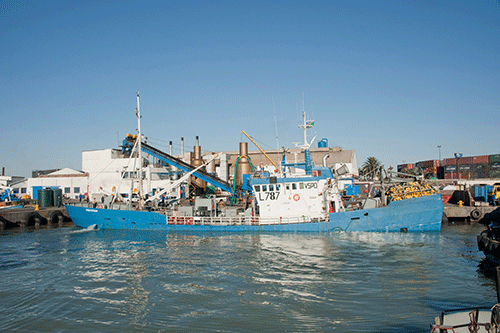WALVIS BAY – The perception that the government is currently allowing fishing in the 200m isobath is misplaced, as it is only an experiment being carried out by two companies in collaboration with the government.
This is according to the fisheries ministry.
Annely Haiphene, the executive director of the fisheries ministry, set the record straight during a press conference held in Walvis Bay last Friday.
She stated that such experiments are not unusual, and that the ministry has conducted three similar experiments in the past.
Haiphene said the previous experiments found no justification for relaxing the regulation as some players in the fishing industry had suggested.
“The restriction has been challenged on several occasions by some players in the fishing industry, with the more recent Wet Landed Horse Mackerel Association (WLHMA) stating that with climate change, lower water temperatures are experienced earlier than before, and larger-sized horse mackerel fish move to shallower waters closer to the shore.
“In their request, the industry sought special consideration to be granted a trial concession to conduct fishing within the 200m isobaths,” Haiphene said.
Namibia’s seabed has been protected for the past 25 years.
However, WLHMA has been calling for them to be allowed access to the restricted area, as they experienced low catches due to horse mackerel migrating to the zone.
This resulted in a decision by the Cabinet to carry out an experiment to see if their claims were true.
However, the government faced criticism from some of the industry players, as allowing fishing in the restricted zone could have disastrous consequences, as the area is regarded as the breeding ground of fish species.
According to Haiphene, however, while the ministry could not ignore the request from the industry, it also could not agree without ensuring the necessary precautions are put in place to ensure the sustainable utilisation of resources.
In addition, the ministry received authorisation to conduct the experiment to collect scientific data and advise appropriately.
At the heart of the experiment is to determine the effectiveness of the 200m isobath in protecting juvenile fish.
“This is not the first experiment being conducted. A series of experiments were conducted by the ministry in the past: in 1996, 2002 and the last one in 2007.
“These experiments were done in collaboration with the midwater trawl industry on board, the midwater trawlers – one inshore and the other offshore of the 200m isobaths.
“Afterwards, the composition of their trawls was compared in terms of species composition, catch rates, length frequencies and other biological indicators,” she said.
However, the current experiment is necessary due to certain changes and patterns in the climate and the industry overall, she emphasised.
The 200-metre isobath restriction on trawling and longlining is one of several management and control measures enforced in Namibia to regulate fishing activities.
In 1990, the government, through the fisheries ministry, implemented this measure to protect juvenile hake and horse mackerel, as well as limit sardine by-catches that occur in this zone due to the mid-water trawl fleet.
Meanwhile, WLHMA chairperson Jason Angala earlier said they remain hopeful the experiment will yield positive results, especially for the horse mackerel industry that has been plagued with low catches.
“If the harvesting of horse mackerel within the restricted zone is permitted at all, only pelagic trawlers equipped with refrigerated seawater (RSW) hold systems will be allowed to do so. No freezer trawlers or companies that own these vessels will be allowed to harvest the species within the restricted zone,” Angala explained.
Currently, the majority of horse mackerel in Namibian waters is harvested by large freezer trawlers that can trawl the whole day with large nets on scattered fish, while the RSW trawlers can only target shoals of horse mackerel that migrate during the winter months.
However, the chairman of the Confederation of Namibian Fishing Association (CNFA), Matti Amukwa, has been opposing the continued calls to open the restricted zone for fishing.
It is Amukwa’s fervent position that the fishing industry plays a strong role in food security and that fishing within the restricted zone will have negative implications for the whole industry.
“The 200-meter isobath was introduced for scientific reasons. The shallow waters are the spawning grounds for most of the commercial species in Namibia. Apart from being the spawning ground for horse mackerel, the restricted area is also the nursery ground for many other fish species that have to grow to a size where they will be able to eventually migrate into deeper waters. Even opening it for experimental purposes will set a dangerous precedent,” Amukwa said.
Caption:


